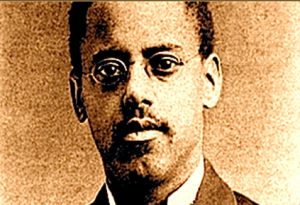Black History Month: Lewis Latimer – The Genius Credited For Making The Light Bulb A Sustainable Invention


One of such inventors was Lewis Latimer: born on the 4th September 1848, in Chelsea, Massachusetts to Mr. and Mrs. George and Rebecca Latimer. His parents were both runaway slaves who came from Virginia to Massachusetts in 1842. However his father George Latimer was later on, recaptured by his slave owner who wanted to take him back to Virginia. His father’s situation caught the attention of Massachusetts Supreme Court, which lead to Mr. George being bought by the abolition supporters who purchased him and then set him free.
Lewis Latimer joined the US Navy during the Civil War and was assigned to U.S. Massasoit gunboat but was later horribly discharge on the 3rd July 1965. After his discharge, he went out looking for a job throughout Boston and Massachusetts where he finally got a job as an office boy with Grosby and Gould Patent Law Firm where he was earning $3.00 weekly. His employer discovered that Lewis has a talent for sketching patent drawings quite well. He was given a promotion to the position of head draftsman where he earned $20.00 weekly.
In 1874, Latimer alongside W.C. Brown co-invented an improved version of a train water closet; a bathroom for railroad trains. In 1876, Latimer was part of one of the most important inventions in the world. Alexander Graham Bell had just invented the telephone and wanted Latimer to draft its drawing for the purpose of applying for a patent for his invention. Latimer worked for many days till late hours in the night so that he could submit the drawings in time, so that Graham can submit his patent applications. Latimer finished the drawing on the 14th February 1876 barely hours before another drawing was submitted by Elisha Gray of the same device.
Latimer later on relocated to Bridgeport, Connecticut where he got a job as the draftsman and assistant manager for the U.S Electric Lighting Company which was owned by Hiram Maxim. Hiram Maxim was an ache-rival of Thomas Edison, the man credited to inventing the electric light bulb. Edison’s invention consisted of a glass bulb covering a carbon wire filament which was made up of paper, bamboo or thread. The bulb worked by having the filament burned inside when electric current passed through the filament and became so hot to the point it glowed. Within this bulb, there was virtually no air.
Maxim was obsessed with improving Edison’s invention and took a keen interest on any flaws Edison’s invention had, more specifically the short life span of Edison’s light bulbs. This is where Latimer came in and made the bulb’s lifespan longer. Latimer devised a method of encasing the bulb’s filament within a cardboard envelope thus preventing the carbon from breaking up thus giving the bulb a much longer lifespan. In addition to this it made the bulb less expensive and efficient, thus essentially making Edison’s invention a sustainable invention that can be used in homes and throughout the streets; this lead to Latimer being sought after to improve on other types of lighting bulbs such as the incandescent lighting and arc lighting.
More cities across US began installing electric lighting on their streets, and Latimer was dispatched out to lead the team planning this exercise. For instance, Latimer was the team leader for the team that installed the first street lights in New York, Montreal and Philadelphia and was also in charge during installation of lights in government building, train station as well as in other countries like Canada and New England.
In 1890 Latimer got a job with Thomas Edison company and worked in the legal department of the Edison Electric Light Company where he worked as the patent expert and the chief draftsman. He did incredible job in this position. 1n 1894, Latimer created a safety elevator which was a significant improvement on the elevators of that time. After this, he got the patent for Locking Racks for Umbrellas, Coats and Racks. This device will later be used in hotels, restaurants and office building across the world. Next he invented a Book Supporter which is used to neatly arrange books on the shelves. After this Latimer invented a devise for making room more sanitary while controlling the temperature. He christened it “Apparatus for Cooling and Disinfecting”; and it found suitable use in hospitals where it prevented dust from circulating inside the hospital and public areas.
Latimer continued to come up with several inventions that were used in improving the day-to-day lives of the general public. Later on, he was involved in the improving of the civil rights for the Black citizens living in USA. He also wrote poetry and music for his friends and family. Lewis Latimer demise came on the 11th December 1928, after he had left an outstanding legacy of discovery, inventions and great leadership which effectively makes him one of the top 10 greatest African American inventors in history.




Comments are closed.